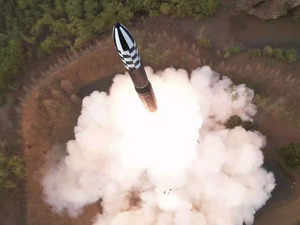- The Chinese nuclear arsenal: According to SIPRI, China upgraded its nuclear arsenal from 350 warheads in January 2022 to 410 warheads in January 2023.
- Potential parity in ICBMs: SIPRI estimates that by the end of the decade, China could have a comparable number of intercontinental ballistic missiles (ICBMs) to the United States or Russia.
- Concerns about the claimed goal: The Weapons of Mass Destruction Programme at SIPRI concerns China’s developing nuclear arsenal and its stated goal of keeping minimal nuclear forces for national security.

Increased Nuclear Arsenals in India and Pakistan
- India’s nuclear arsenal: According to SIPRI estimates, India’s nuclear arsenal increased from 160 warheads in 2022 to 164 warheads in 2023.
- Pakistan’s nuclear arsenal: According to SIPRI, Pakistan’s nuclear arsenal will have grown from 165 warheads in 2022 to 170 warheads in 2023.
- Longer-range weapons: India appears to be emphasising longer-range missiles capable of hitting targets throughout China, but Pakistan remains the principal focus of India’s nuclear deterrent.
Global Nuclear Weapons Stockpile
- Total global inventory: The total global inventory of warheads stood at 12,512 as of January 2023.
- Warheads in military stockpiles: Approximately 9,576 warheads were maintained in military stocks for future deployment, an 86-warhead increase from January 2022.
- Dominance of Russia and the United States: Russia and the United States together hold almost 90% of all nuclear weapons.
- Nuclear arsenal stability: According to SIPRI, the size of Russia’s and the United States’ nuclear arsenals remained generally steady in 2022, however transparency regarding nuclear forces reduced due to the Ukraine crisis.
Reasons for a larger stockpile
- Shifting power dynamics: China’s rapid buildup of its nuclear arsenal has ramifications for global power dynamics, potentially challenging the US and Russia’s longstanding nuclear dominance.
- Concerns about regional security: China’s expanding nuclear capabilities have alarmed neighbours, particularly those involved in territorial disputes or security rivalry in the Asia-Pacific area.
- Global arms race: The expansion of China’s nuclear arsenal may drive a regional arms race, leading to heightened tensions and instability.
South Asian Nuclear Dynamics
- Strategic rivalry between India and Pakistan: The nuclear arsenals of India and Pakistan continue to grow, reflecting the two countries’ continued strategic competition and deterrence dynamics.
- Risks of escalation: The increased nuclear capability in South Asia raises the possibility of miscalculation and escalation, increasing the risk of a nuclear confrontation in the region.
- Implications for regional stability: The expansion of India’s and Pakistan’s nuclear arsenals has broader implications for regional stability and the success of non-proliferation efforts.
Challenges to the Ideals of Global Disarmament
- Transparency is deteriorating: The lack of transparency regarding nuclear forces in Russia and the United States, combined with a growth in worldwide warhead stockpiles, poses problems to nuclear arms control and disarmament efforts.
- Trust is eroding: Lack of transparency and growing stockpiles erode trust among nuclear-armed states, making significant progress in disarmament negotiations more difficult.
- A revitalised dialogue is required: The increasing nuclear arsenals highlight the urgency of reviving international disarmament talks and reinforcing current arms control treaties.
Legacy concerns
- Nuclear ‘Haves’ and ‘Have-Nots’: Proponents of disarmament are nuclear-armed countries themselves, creating a nuclear monopoly.
- PNE (Peaceful Nuclear Explosion) concept: performed for non-military purposes such as mining.
India’s commitment to nuclear disarmament
- Universal commitment and a non-discriminatory framework: India advocates for nuclear disarmament based on equality, non-discrimination, and global security principles.
- Working paper on Nuclear Disarmament: In 2006, India presented to the UN General Assembly a working paper on Nuclear Disarmament, outlining its viewpoints and suggestions for achieving global disarmament.
- Participation in Nuclear Security Initiatives: India actively participates in the Nuclear Security Summit process and supports efforts to improve global nuclear security by participation in IAEA-organized international conferences.
- India is a member of the Nuclear Security Contact Group, where it contributes to talks and activities aimed at increasing international cooperation on nuclear security.
- India indicates willingness to support negotiations on a Fissile Material Cut-off Treaty (FMCT), viewing it as a crucial step towards disarmament by prohibiting the manufacture of fissile material for nuclear weapons.
- Concerns about the Comprehensive Nuclear-Test-Ban Treaty (CTBT): India has not joined the CTBT due to many concerns, but it remains open to addressing these concerns and studying options for future treaty entry.
- Leadership in Preventing Weapons of Mass Destruction (WMD) Proliferation: India actively leads efforts to prevent terrorists from acquiring WMDs, piloting an annual United Nations General Assembly Resolution on “Measures to Prevent Terrorists from Acquiring Weapons of Mass Destruction” since 2002, which receives consensus adoption.
The way forward
- Increasing non-proliferation efforts: The buildup of nuclear arsenals emphasises the importance of strong non-proliferation systems and adherence to international treaties such as the Treaty on the Non-Proliferation of Nuclear Weapons (NPT).
- Nuclear risk management: As the number of nuclear-armed states grows, effective risk management and confidence-building measures are becoming increasingly important in order to prevent the accidental or intentional use of nuclear weapons.
- Deterrence and disarmament must be balanced: To sustain global security, the international community must strike a balance between maintaining credible deterrence and achieving disarmament goals.
Source: https://economictimes.indiatimes.com/news/defence/global-nuclear-arsenal-grew-last-year-sipri-says/articleshow/100932204.cms
